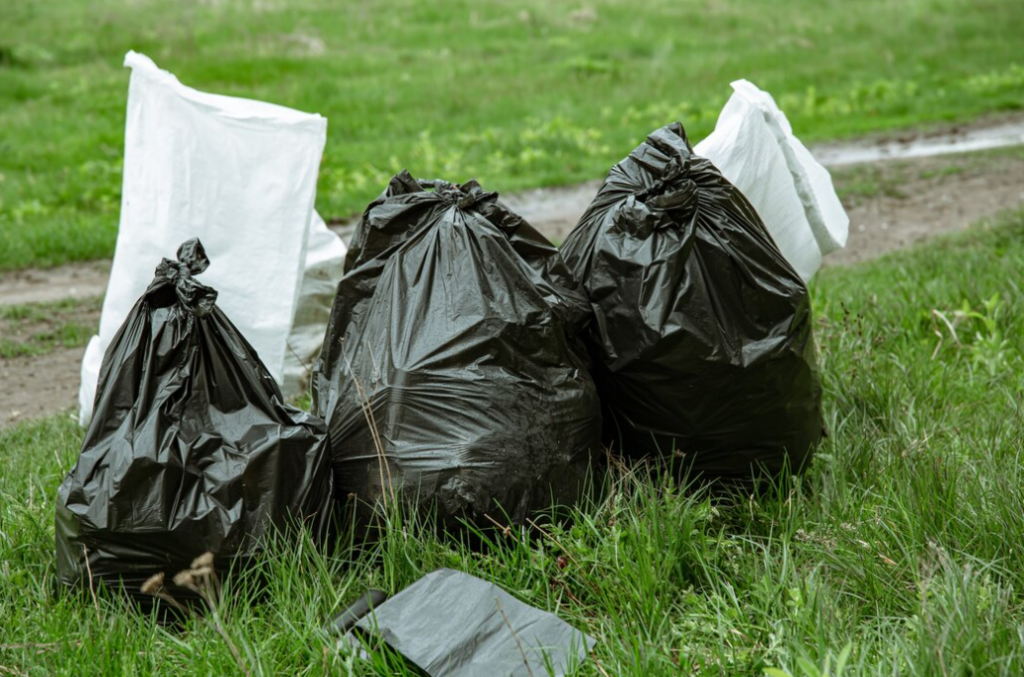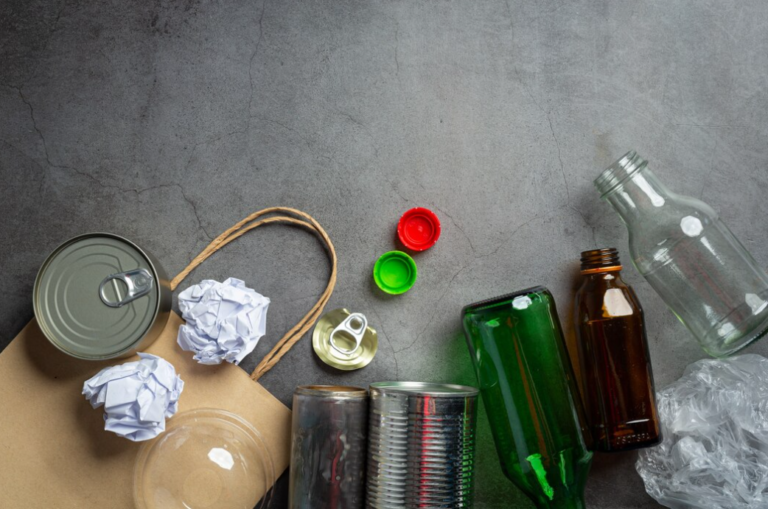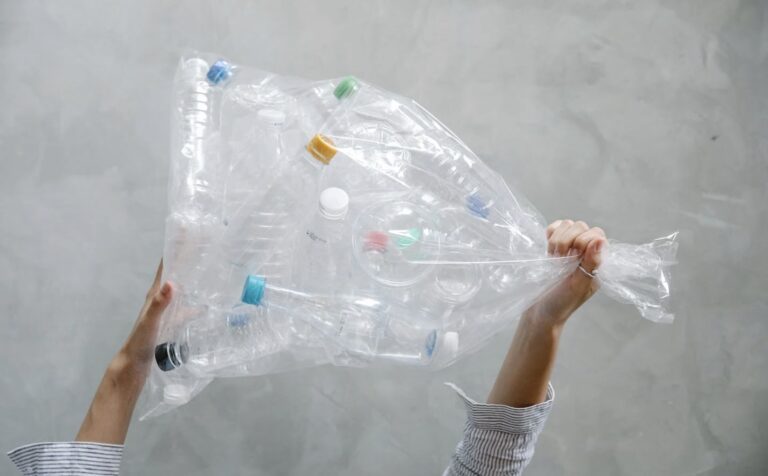Garbage bags, commonly referred to as trash bags or bin liners, seamlessly integrate into our daily lives as indispensable tools in waste management. While they quietly perform their duty of containing refuse, ensuring that our living spaces remain clutter-free and hygienic, we rarely pause to acknowledge the science and innovation behind their creation. Their capability to hold varying weights, resist punctures, and prevent leaks is a testament to their well-thought-out design and material selection. But have you ever wondered how garbage bags are made and how they’re manufactured? This article dives into the composition of garbage bags and explores their material makeup.
| Resin Type | Description |
|---|---|
| Low-density polyethylene (LDPE) | A polyolefin variant with a specific molecular structure, best known for its flexibility. |
| Linear low-density polyethylene (LLDPE) | Offers a balance between the properties of LDPE and HDPE, frequently used for its versatility. |
| High-density polyethylene (HDPE) | Recognized for its superior strength and puncture resistance among the three types. |
Low-Density Polyethylene (LDPE)
- Properties: LDPE is recognized for its flexibility and toughness. It’s a petroleum-based resin with a loosely packed molecular structure;
- Use: Predominantly used in the manufacturing of lower-end utility bags and some general-purpose trash bags.
Linear Low-Density Polyethylene (LLDPE)
- Properties: LLDPE has shorter molecular branches, enabling it to move without entangling, making it stronger than LDPE;
- Use: It’s the go-to choice for garbage bags, especially those that require a balance of strength and flexibility. LLDPE bags can withstand sharp-edged waste better.
High-Density Polyethylene (HDPE)
- Properties: HDPE possesses limited molecular branching, making it rigid and less permeable than LDPE. It offers excellent moisture protection;
- Use: Ideal for lightweight trash, HDPE is also the material of choice for grocery bags due to its unique strength-to-density ratio.
LDPE (Low-Density Polyethylene), LLDPE (Linear Low-Density Polyethylene), and HDPE (High-Density Polyethylene) are all part of the versatile polyolefin family, but their individual molecular structures impart them with unique qualities that directly influence the performance of garbage bags. Notably, these plastics share the fascinating characteristic of having a specific gravity less than that of water, causing them to effortlessly float. By delving deeper into the properties and attributes of these three resin types, you can gain a better understanding of how to make a well-informed and cost-effective choice when selecting the ideal garbage bags that not only align with your financial considerations but also cater to your specific needs.
Environmental Impact

The use of plastic bags, encompassing everything from shopping bags to garbage bags, has long been under scrutiny due to their environmental implications. While there’s no denying the convenience and utility they bring to our daily lives, the lingering aftereffects of their disposal are concerning. A significant portion of these bags, given their non-biodegradable composition, end up polluting landscapes, waterways, and marine environments, sometimes for hundreds of years. This has led to detrimental effects on wildlife, with animals often mistaking them for food, and has contributed to the global plastic pollution crisis.
Recognizing these issues, many countries and organizations are pushing for more sustainable alternatives. Recent innovations focus on biodegradable and compostable garbage bags. These are designed to decompose much faster under the right conditions, leaving behind a much smaller environmental footprint. Furthermore, increased public awareness campaigns are highlighting the importance of reducing, reusing, and recycling, encouraging everyone to play their part in mitigating the plastic problem.
- Non-Biodegradable: Most plastic bags are non-biodegradable, which means they do not naturally break down over time;
- Waste Accumulation: The widespread use of plastic bags contributes to the accumulation of plastic waste in landfills and natural environments;
- Wildlife Hazard: Plastic bags can pose a significant threat to wildlife when they are ingested or entangled in them;
- Resource Depletion: The production of plastic bags consumes valuable natural resources, including oil and gas;
- Energy Consumption: The manufacturing and transportation of plastic bags require significant energy inputs, contributing to carbon emissions;
- Microplastics: Over time, plastic bags break down into smaller pieces, creating microplastics that can harm ecosystems and enter the food chain;
- Air and Water Pollution: The incineration and improper disposal of plastic bags can release harmful pollutants into the air and water;
- Reduced Aesthetics: Littered plastic bags can reduce the aesthetic appeal of landscapes and water bodies;
- Overconsumption: The convenience of single-use plastic bags can lead to overconsumption and a culture of disposability.
Low-Density Polyethylene in Trash Bags
Originating as an early resin, low-density polyethylene (LDPE) continues its legacy in certain utility trash liners, even if they’re on the more economical end. Imperial Chemical Industries pioneered the creation of this thermoplastic in 1933. Molecularly, LDPE stands out due to its loosely arranged structure and the most branching among all polyolefins. These traits contribute to its lower density, reduced tensile strength, and enhanced flexibility.
Beyond trash bags, LDPE finds its application in diverse products like wash bottles, containers, dispensing bottles, and computer components. However, in the realm of trash bag production, LDPE has seen a gradual shift towards its successor, linear low-density polyethylene.
Low-Density Polyethylene in Trash Bags
Distinguished by numerous short branches, Linear Low-Density Polyethylene (LLDPE) sets itself apart from LDPE, primarily because it lacks extensive chain branching. While LLDPE showcases shorter molecular offshoots, they can move fluidly without entanglement. On the other hand, LDPE features longer chains that tend to get entangled. Owing to these structural differences, LLDPE outperforms LDPE in strength, making it a preferred choice for trash bag manufacturing.
Indeed, LLDPE bags dominate the market, renowned for their resistance against punctures and superior impact endurance. Their inherent resilience against tears and punctures positions them perfectly for situations demanding added elasticity and strength. Specifically, these robust bags can hold waste with sharp contours or jagged edges with ease. Here are some notable benefits of trash bags crafted from LLDPE:
- LLDPE garbage bags are versatile, and suitable for various uses;
- Compared to HDPE counterparts, these bags demonstrate superior stretchability and top-notch puncture resistance;
- LLDPE trash bags are available in an extensive palette of colors;
- LLDPE bags, when contrasted with traditional low-density resin bags, can be produced with a thinner gauge without compromising strength.
High-Density Polyethylene in Trash Bags
High-density polyethylene (HDPE) is characterized by limited molecular branching. This sparser branching renders HDPE less permeable and more rigid compared to LDPE. Bags made from HDPE stand out for their temperature resilience, impressive strength-to-density metrics, and outstanding moisture barrier capabilities.
HDPE trash bags are optimal for bathrooms, light waste, and paper disposal. Their remarkable strength also makes them a popular choice for grocery store bags. However, it’s worth noting that while HDPE bags are robust, they are prone to tearing when punctured. Some standout features of HDPE waste bags are:
- These trash bags are roughly three times as robust as LDPE bags of equivalent thickness;
- HDPE garbage bags provide notable cost efficiency per bag;
- Producing HDPE garbage bags demand two-thirds less petroleum-derived materials;
- HDPE trash liners can lead to savings in shipping, storage, and warehouse expenses;
- HDPE-based trash bags withstand a broad temperature spectrum, ranging from -40°F to +212°F (boiling point).
LLDPE vs HDPE: Comparing Garbage Bag Types
Let’s dive into a direct comparison between the two leading trash bag materials: LLDPE and HDPE bags:
| HDPE Garbage Bags | LLDPE Garbage Bags | |
|---|---|---|
| Efficiency of the Material | The Best Material Savings | Good Material Savings |
| Tear Resistance | Good Resistance to Tearing | Better Resistance to Tearing |
| Puncture Resistance | Good Resistance to Puncturing | Better Resistance to Puncturing |
| Load Capacity | Good Load Capacity | Good Load Capacity |
Choosing the Right Garbage Bag
Selecting an appropriate garbage bag goes beyond merely grabbing the first one you come across on a store shelf. The nature of the trash and its specific requirements dictate the type of bag you should use. Here are some considerations based on different types of waste:
- Kitchen Waste: The kitchen is a hub for diverse waste, from food scraps to liquid spills. For such varied refuse, you’ll need a bag that’s both durable and leak-proof. Garbage bags made from LLDPE are specifically designed to handle wet waste and are resistant to punctures, making them an ideal choice for kitchen needs;
- Yard Waste: Outdoor tasks like gardening, landscaping, or simple yard cleanups result in waste that’s bulky and sometimes has sharp or rough edges. LDPE bags, recognized for their adaptability and resilience, are adept at managing such waste, making them a preferred choice for yard debris;
- Office Trash: In a typical office setting, the waste is predominantly paper, wrappers, and other lightweight trash. Such trash doesn’t necessarily need heavy-duty bags. HDPE bags, which are light yet robust, are perfectly suited for this role. They can handle the usual office waste efficiently without being too bulky or cumbersome.
Conclusion
Grasping the composition of garbage bags and selecting the appropriate liner type can profoundly impact the operational efficiency and cost-effectiveness of your business. Through comprehensive insights and expertise, organizations like AAA Polymer have consistently assisted clients in making informed decisions, leading to substantial savings. By transitioning from pricier options to more tailored solutions, businesses can optimize their resources and achieve better sustainability and cost management.









+ There are no comments
Add yours